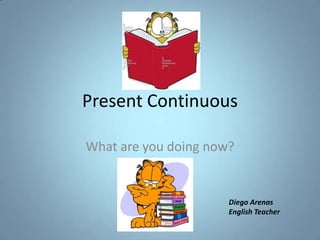
Present continuous
- 1. Present Continuous What are you doing now? Diego Arenas English Teacher
- 2. Rules We use the present continuous tense when we want to express or describe an action that happens at the time we are speaking. For example ,at this moment ,you are reading this presentation, so the action is happening now. The clue to form this tense is to remember that you have to use the auxiliary verb To Be conjugated in one of its 3 ways in present (am – is – are) and the ending –ing in the main verb. Example: You are reading now. I am writing at the moment. The students are learning a new verb tense.
- 3. Affirmative The affirmative form is created this way: Subject + am – is- are + Verb –ing + complement Tom is drawing a map. The baby is crying on the sofa. My friends are playing basketball. I am doing the dishes. • Remember that you have to remember to conjugate this tense correctly, do not forget the verb to be or the –ing ending. •Correct: I am cleaning the table Incorrect : I cleaning the table He is watching TV He is watch TV.
- 4. Negative The negative form is very simple, in this part you have to add the word NOT between the verbs. Example: The baby is NOT crying in the sofa. Then you have to follow the previous rules. Examples: I am not jumping. She is not watching football. We are not eating rice. When having a conversation and you mention a negative idea, try to express or correct that idea, just to continue or clarify something in this conversation. Example: My brother is not studying, he is playing computer games because today is Sunday.
- 5. Yes –No Questions I also call them confirmation questions, because you want to confirm something through a Yesor No answer. In this case we take the verb to be and change places with the subject of the sentence. Example: Are you waiting for the bus? Am-is-are+ Subject+Verb ing+ Complement+? Is he looking for a gift? Am I doing this right? So, for all these questions a simple yes or no will be a proper answer. That is what I want to know, just a simple Yes or NO. Are you waiting for the bus? Yes, I am. Or No, I’m not. Is he looking for a gift? Yes, he is. Or No, he isn’t.
- 6. When you answer a Yes – No questions with a negative answer. Try to provide a corroboration to that answer. Example: Are you waiting for the bus? No, I am not. I am waiting for a taxi. There are different ways to answer these questions. We can divide those ways in formal or informal, it depends on the conversation or the people you are talking to. Are you John? No. This is a bit rude Are you John? No, I’m Paul. This is polite. Is he studying maths? No, he is not. This is formal. Is he studying maths? No, he isn’t. This is informal.
- 7. Wh- Questions Or Information questions are formed with the questions the following questions words: What: Related to things, actions. Where: Related to places or locations. When. Related to time. Days, moments, months, etc. Why: Related to reasons. Who: Related to people. How: Related to mood, or feelings.
- 8. We form the questions like this: What are you doing now? Wh- + am-is -are +Subject + Verb ing + Complement+? And we provide more and new information in our answer. What are you doing now? I am reading the newspaper. Where are you going? I am going home. Who are you talking to? I am talking to my friend. How are you feeling today? I am not feeling well. Why are you smiling? Because I am watching a comedy.
- 9. Future plans and arrangements. We also use the present continuous tense to talk about future, when we have plans and arrangements. Example: What are you doing tomorrow? I’m going to a party. What are you doing next summer? I’m going to the beach. In this case we have to mention when the actions are going to take place. That’s why we use some certain time expressions.
- 10. Time expressions: There are certain time expressions we use in order to express that an action is happening in a specific period of time, specially in a continuous tense. Examples: For the moment of speaking: Right now. Today At the moment. Now. Currently. At the moment. This week This month For plans and future arrangements: Tomorrow Next week Next Friday
- 11. Other ideas You can also use contractions, but do not use them when you want to be formal. I’m not , He’s not or He isn’t , She’s not or She isn’t , It’s not or It isn’t, We’re not or We aren´t, They’re not or They aren’t. All of these are contractions, but you do not use them in a formal letter. Informal: They’re not playing football. Formal. They are not playing football. They’re waiting for a taxi. They are waiting for a taxi.
- 12. Time for practice Go back to the time expressions slide. Then create at least 1 idea per expression. Once you finish, think about the things you are doing right now. I bet you are thinking in at least 2. But there are many more actions that you are performing at the same time… …interesting, isn’t it? See you soon for another English slide.
